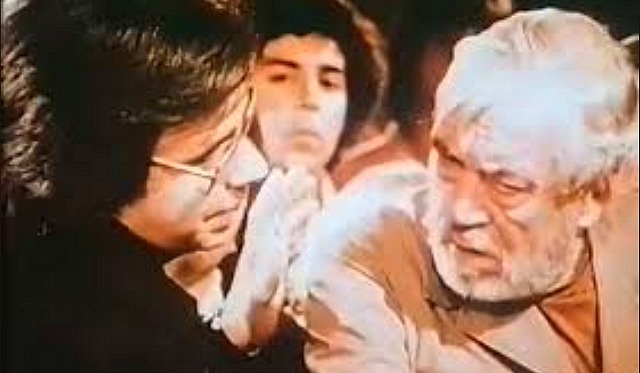
I do know this aboutOrson Welles‘ The Other Side of the Wind - When it will premiere at Venice next September, the reviews will most likely mention how odd of a narrative collage it is.
A few years before embarking on "The Other Side of the Wind," Welles had made "The Immortal Story," a 60-minute made-for-French-TV oddity. Before that, he was coming off the trifecta of "Touch of Evil," "The Trial," and "Chimes at Midnight." What many fail to realize was that, at this phase in his career, Welles decided to radicalize himself and push the boundaries a little more. A sort of radical, Godard-ian phase for him. Which could explain why so many failed and/or unfinished projects resulted after "Chimes of Midnight," Wells wanted to reinvent cinema, but he was sure how and he wasn't sure who would give hum funding for such experimental ventures. He did manage to squeeze a film out of this radical phase, his last one, in fact, 1974's "F For Fake.""The Other Side of Hope" was supposed to be the other.
Last May, an Indiegogo campaign was launched to help complete Welles' final, but unfinished, film. The six-year shoot of "The Other Side of the Wind" was plagued by budget cuts, troubles in production, casting and other legal issues. It remained unfinished at the time of Welles’ death in 1985.
Netflix took on the task and nabbed the global rights to the film, the deal implied that they were to finance the completion and restoration of "The Other Side of the Wind."
Director Rian Johnson attended a special screening of the film [Vanity Fair], claiming he had seen a 117-minute edit twice. A screening in Santa Monica, California, on January 16, 2018 with Quentin Tarantino, Alexander Payne, Paul Thomas Anderson, and other VIPs, who "were all gobsmacked."
"As a Welles fan, this movie lands so hard," Johnson said. "On a style level, it's cut in a way that feels slightly beyond where we are now. It's got a very fast, collage-like feel. This movie keys directly into what's grand and tragic about (Welles') later years. It taps directly into the fuse box of that tragedy. I've seen it twice, and I need to see it a dozen more times."

The synopsis of the film is as follows: "The film covers the 70th birthday party of movie director Jake Hannaford, who is struggling to make a commercial comeback. It opens with Hannaford's death just after the party, and mostly focuses on the night before his death. We also see extracts of Hannaford's daring new film-within-a-film, The Other Side of the Wind. As we learn more about Hannaford at his party, the audience realises that he is a far more complex character than he seems, and harbors several big secrets."
"The film presents a cynical portrait of Hollywood in the 1970s, parodying the passing of the studio system, and the experimental new film-makers of the new Hollywood, as well as mocking successful European directors such as Antonioni. It was shot in a variety of different styles—color, black-and-white, still photography, 8mm, 16mm and 35mm film, all rapidly intercut together, and was planned as a collage of these different styles."

A source on HE: “Orson had a feature script. He shot that movie, infamously, over a period of years. Then he fine-cut the 42-minute version. Then he got busy, got distracted and then died. The 42 minutes were scenes from different parts of the story. The 42-minute reel is famous because its cutting style is so radical — Orson was trying to reinvent editing and shooting styles, as collage.
“The only thing I can compare it to would be parts of JFK, decades later, where Oliver Stone and Bob Richardson were intercutting lots of film stocks and jumping around, to keep you off-balance.
“The footage has two styles — (a) the cutty, jumpy documentary style, which follows the characters, and (b) the movie-within-the-movie, which [offers] a very composed, beautiful, landscape type of photography, sort of mocking Antonioni. But none of this is secret. The footage has been circulating for decades. The script has been published. So this radical style has been known forever.
“The editing team has cut the remaining uncut footage, doing their best to follow the two editing styles which Orson already established. The result is pretty seamless. It is very definitely of the time — it feels very early ’70s experimental. A hint of what he was going for would be in his other film from this era, F For Fake, which is heavy on collage. Orson called it an ‘essay film.’ If you watch that movie, you’ll get a sense of what Orson was up to. He was trying to throw out the rules and reinvent things.





